|
|
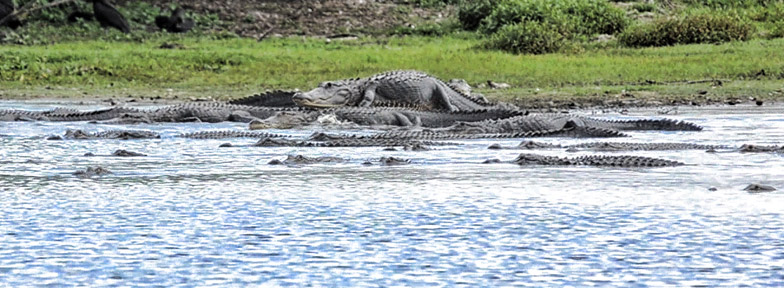 |
 heets of heavy rain pour from the stormy sky, lightning flashes and deep thunder echoes across the vast marsh fields. Feathers soaked, swamp birds fold their beaks under their wings, attempting to ward off some of the torrential down pour. heets of heavy rain pour from the stormy sky, lightning flashes and deep thunder echoes across the vast marsh fields. Feathers soaked, swamp birds fold their beaks under their wings, attempting to ward off some of the torrential down pour.
Looking for fresh water mussels, a pair of raccoon’s scurry along the shoreline. As they pass, the black eyeballs of a large alligator rise above the water. Seeking out his next meal, the alligator ever so slowly slithers towards the bank and an unsuspecting water bird feeding along the plants.
Below the water’s surface, it never rains. Only the indents of raindrops and millions of ringlets can be seen through the yellowish brown colored water. Fish dart among the thick grass roots, feeding on a smorgasbord of insect larva while hiding from the long-legged surface predators.
Here on the Florida’s Myakka River, it is the rainy season and life both above and below the waters surface thrives. But the dry season is quickly approaching and with it the life within the river will drastically change. |
|
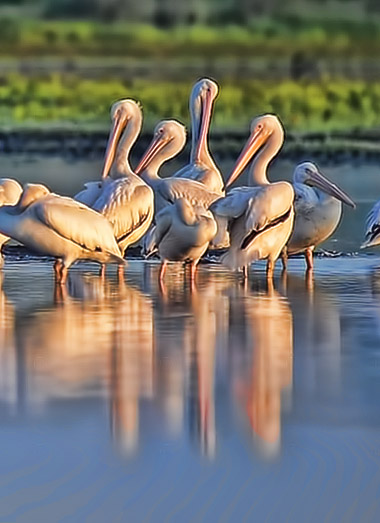 |
|
 |
Cooler temperatures bring months of dry air with little to no rainfall. The once swollen rivers and streams with plenty of room to move and hide quickly diminish into smaller and smaller streams and pools. As the drought continues, fish are pushed tighter into smaller streams. If life didn’t seem difficult enough, the skies fill with the sounds of northern migratory birds, all seeking the approaching banquet.
Life as a fresh water fish within the river is quickly becoming challenging. The diminishing waters provide little protection from the increased number of birds, mammals, and hungry alligators. In an attempt to survive the onslaught of stabbing beaks, grabbing paws, and rows of sharp teeth, fish naturally seek deeper water to hide.
As the water levels continue to fall, thousands of fish funnel into a mysteriously deep circle of water. At first there is plenty of space to move, hide and feed, but as the drought continues and the river levels fall to critical lows, the deep circle that once provided a place of protection now reveals itself as the “Ultimate Death Trap”. |
|
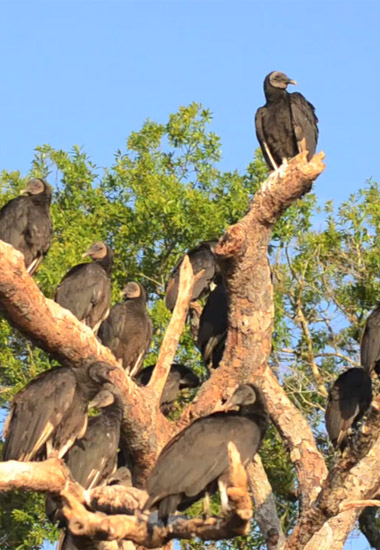 |
|
The prop of our single engine plane roars loudly as we fly west over the winding river of grass called the lower Myakka Lake. Crossing a man-made dyke covered in tall yellow grass, the pilot banks hard right and a great circle of dark water appears along the shoreline. Over a hundred alligators bask on its eastern shore, soaking up the mid-day heat. Circling back, wild hogs scamper from the shallow river water as the pilot passes once more. This is the mysterious and remote location we have come to explore – a potentially ancient cave system, hidden below a perfect camouflage of black water.
Located several miles into the lower Myakka Lake Wilderness Preserve, Deep Hole is what the state park’s maps name this unique site. It is a mysterious hole with only fabled stories of attempted exploration and wild adventure. |
|
|
|
| |
Organizing a meeting with the ADM Exploration Foundation, Sarasota County, and the Myakka River State Park, we combine efforts and draft a scientific proposal to learn more of what lays below the circle of black water.
Our newly formed team of scientists, archeologists and expert cave explorers come together at the southern park gate on January 25th, 2012. A long drive down a winding dirt road, lined by palmetto brush and straggly oak trees charred by recent brush fires, leads us along the northern shore of the lake. The extreme drought has lowered the river to record levels and we safely drive out onto the lakebed and up to the side of the mysterious circle of water.
|
|
|
|
Stepping out of the four-wheel drive vehicles, hundreds of vultures circle in the sky as we stand for the first time on the shore of this 200-foot diameter pool. The air is filled with the sounds of marsh birds, as a light breeze blows ripples across the tannic water. Like a scene from early Tarzan movies, over a hundred alligators, six to thirteen foot in size, bask on the distant shore. Several raise their heads, mouths gaping wide, as they attempt to control their inner core temperatures. Dozens of additional alligator heads floating on the water’s surface slowly gaze in our direction. Truly a magnificent display of the way Florida looked for thousands of years before man encroached.
Our task for this day is simple and consists mainly of learning as much as possible about the wildlife, the water conditions, and the location of the submerged cave system within the circle of black water. Important facts needed to continue our exploration mission.
By the end of the day our team has gained much knowledge. Over the next two months we return on multiple occasions to shoot photos, recover water samples, test surface sonar units, and, more importantly, study the behavior of the alligators to prepare ourselves for the inevitable dive exploration day and an attempt to be the first to fully document the mystery below.
The Dive Day
To descend into the inky blackness, professional underwater cave explorers, Curt Bowen of the ADM Exploration Foundation and Jim Culter of Mote Marine, organize their specialized cave diving equipment as the other team members prep the down lines and lowered the “shark cage”, converted into a temporary alligator cage, into the water.
During the previous two months of studying the behavior of the alligators within the sink, we noted two very curious ten-foot reptiles who commonly poked their noses close to check out what the team was doing, often attempting to chew on any object not moving fast enough to get away. |
|
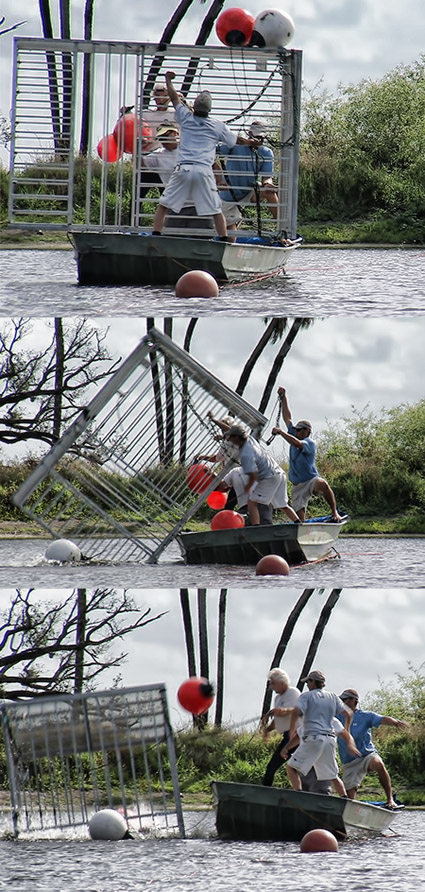 |
|
|
|
The initial swim to the center of the alligator hole and drop to the bottom does not concern the divers, but the thirty to sixty minutes of decompression obligations at the end of the dive in shallow black water does. Thus they chose to use the safety and peace of mind of the cage to complete required decompression stops.
Upon entering the water, visibility quickly diminishes to no more than 18 inches of reddish-yellow tannic water. Swimming to the center of the pool the divers descend quickly into the darkness. Hands on the down line, the two divers reach the top of the alligator cage located at a depth of thirty feet. After clipping off extra decompression scuba cylinders to the cage, they give a close OK signal and separated into the blackness. Due to the poor visibility expected, both divers previously agreed upon conducting a solo dive within the depths of the cave and coupling back up within the decompression cage. Attempting to stay in contact in these extreme conditions would be impossible, wasting time and energy needed to concentrate on the tasks at hand.
Descending further down the line to the bottom, they discover a harsh, cold, 57-degree environment, heavy with hydrogen sulfide created from hundreds of years of decaying plant, fish, and animal remains. Curt Bowen ties off an exploration reel, followed the slope of the mound downwards until reaching a wall, turns right, and circumnavigates the entire sink bottom, searching for possible ongoing cave passage or deep pits. Jim Culter also ties off an exploration reel and searches the surface of the silt mound for possible archeological discoveries. The divers then return to the line and complete deep decompression stops on their way back to the safety of the shallow cage. |
|
 |
|
The discovery of the “Ultimate Death Trap”:
With water levels at record lows, Deep Hole is separated from the winding Myakka River. Fish seeking shelter from predators within the depths of the hole are now trapped, unable to escape until the rains return and the river once again rises.
The fish hoped the deep water of the sink would become a haven, protecting them from the reaches of hungry predators, but instead they find themselves trapped between over a hundred alligators and the cold, none oxygenated water trapped within the sinkhole. Unable to swim deeper than 20 feet without suffocating from lack of oxygen or escaping into the river, they have no choice but to wait out the rains while evading the alligators lest the become alligator food or perish into the cold black anaerobic sink below.
Discovery of the “Mound of Decomposition”
As the divers explore the bottom of the sink, they note the large amounts of decaying plant matter and an astonishing number of dead, decaying fish lying within the debris mound. The zero dissolved oxygen, coupled with the cold, 57-degree water and extremely high hydrogen sulfide gas, create a perfect time capsule of preservation. What would normally take only a few weeks on the surface to decay, most likely would last months, if not years, deep within the sink.
Ascending to the surface, the divers find themselves returning to the present day, leaving the newly discovered, entombed time capsule below, guarded by a hundred prehistoric sentinels.
|
|
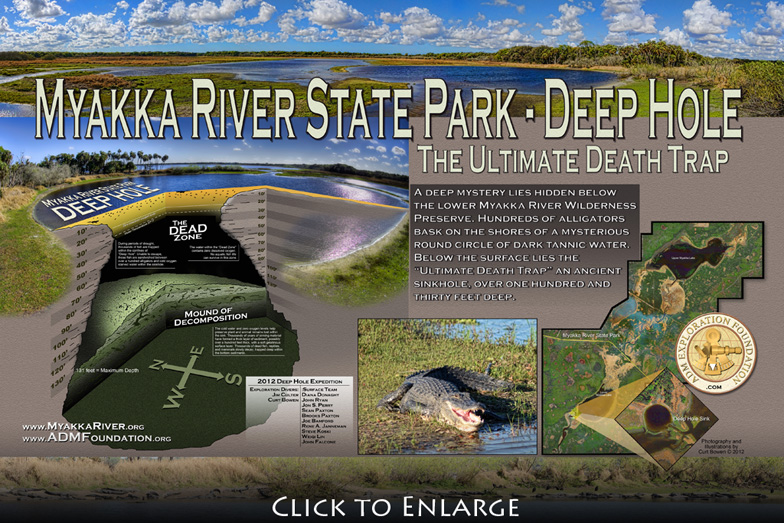 |
| |
|
|
Deep Hole is protected within the Myakka River Wilderness Preserve. Access is limited and granted by permit only. No diving or playing with the alligators is allowed.
Disclaimer: No alligator was harmed or harassed during the exploration project. The inquisitive alligators chose to inspect our activities on their own free will.
Note: Flying an aircraft over a Florida wildlife preserve is controlled by Florida Administrative Code 62D and FAA regulations, limited and special restrictions apply.
|
|
|